 To enhance service speed and avoid tariff delays, we've opened a US warehouse. All US orders ship directly from our US facility.
To enhance service speed and avoid tariff delays, we've opened a US warehouse. All US orders ship directly from our US facility.
| Cat. No. | Product Name | Field of Application | Chemical Structure |
|---|---|---|---|
| DC23914 | Thymalfasin Featured |
An immunoactive peptide that has been shown to inhibit cell proliferation and induce apoptosis in human leukemia, non-small cell lung cancer, melanoma, and other human cancers.
More description
|
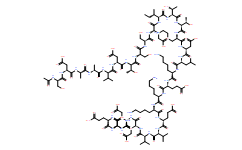
|
| DC9553 | Carbetocin Featured |
Carbetocin (marketed under brand names such as Lonactene and Duratocin) is a synthetic analogue of oxytocin, specifically designed for use in obstetrics to prevent and manage postpartum hemorrhage (PPH), a leading cause of maternal mortality worldwide. It is a long-acting agonist of peripheral oxytocin receptors, making it highly effective in inducing uterine contractions and reducing bleeding after childbirth.
More description
|

|
| DC67100 | Cetrorelix Featured |
Cetrorelix is a potent gonadotrophin-releasing hormone (GnRH) antagonist. Cetrorelix inhibits the endogenous luteinizing hormone surge during ovarian stimulation. Cetrorelix reduces cyclophosphamide induced ovarian follicular destruction in mice.
More description
|
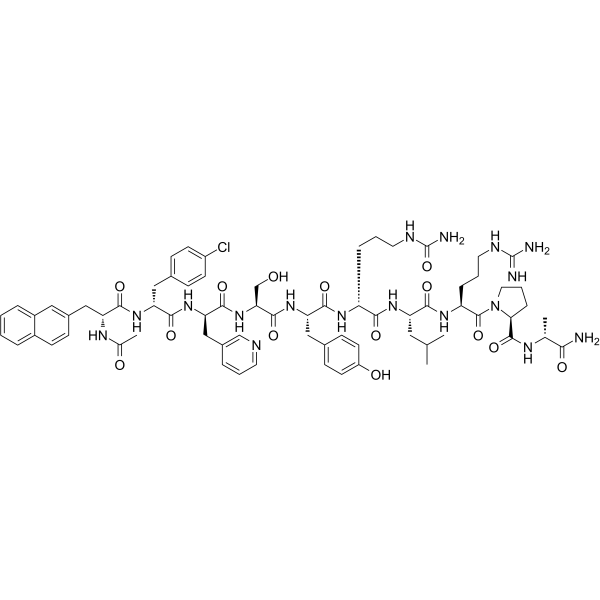
|
| DC70134 | Oxytocin Featured |
A peptide hormone and neuropeptide that is released into the bloodstream as a hormone in response to stretching of the cervix and uterus during labor and with stimulation of the nipples from breastfeeding.
More description
|

|
| DC23939 | Atosiban Featured |
Atosiban (RW22164; RWJ22164) is indeed a nonapeptide and a competitive antagonist of the vasopressin and oxytocin receptors. It is structurally similar to oxytocin but lacks the amino group at the N-terminus, making it a desamino-oxytocin analogue. Atosiban is primarily used as a tocolytic agent, which means it helps to inhibit premature labor by blocking the action of oxytocin on the uterus. This makes it particularly valuable in the management of spontaneous preterm labor, as it can help delay delivery, providing critical time for administering corticosteroids to enhance fetal lung maturity or for transferring the mother to a facility with appropriate neonatal care.
More description
|
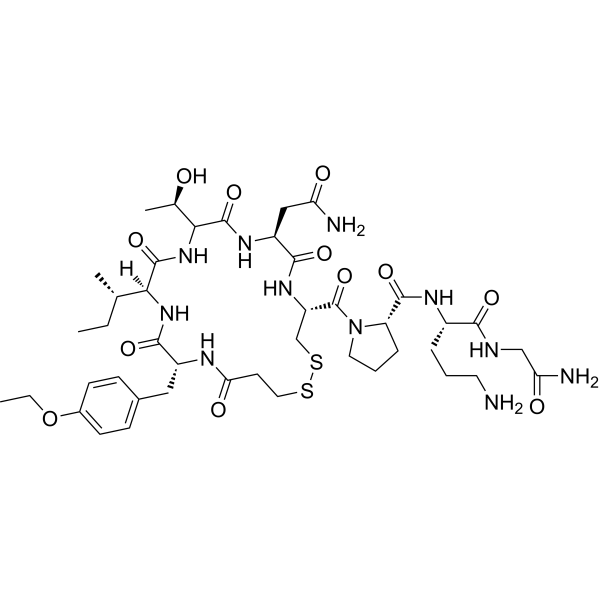
|
| DC73949 | CMP05-7 Featured |
CMP05-7 (Endosomolytic compound CMP05-7) is a novel endosomolytic small-molecule compound that exhibits higher transfection efficiency/ability to induce endosomal escape of oligonucleotides (ONs) than current compounds such as chloroquine.
More description
|
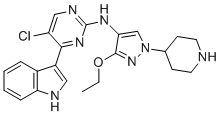
|
| DC74372 | CDD-1281 Featured |
CDD-1281 (CDD1281) is a potent, selective inhibitor of BMP type 2 receptor BMPR2 with IC50 of 1.2 nM and Kiapp value of 8 nM.
More description
|

|
| DC66463 | FAPI-46-NOTA Featured |
NOTA-FAPI-46 is an analogue of FAPI-46 (MedKoo Cat#207189). NOTA-FAPI-46 is useful in the diagnosis or treatment of a disease characterized by overexpression of fibroblast activation protein (FAP). NOTA-FAPI-46 can be used as a PET tracer for detection of diseases or disorders related to fibroblast activation protein.
More description
|

|
| DC66461 | SH-FAPI-4 Featured |
SH-FAPI-4 is a specific fibroblast activation protein inhibitor (FAPI) compound that belongs to the FAPI family of molecules. SH-FAPI-4 is expected to selectively accumulate in FAP-positive tumors and disrupt the functions of cancer-associated fibroblasts (CAFs) within the tumor microenvironment. By inhibiting FAP activity, this compound aims to potentially slow tumor growth, enhance the efficacy of other cancer treatments, and modulate the tumor microenvironment.
More description
|

|
| DC12287 | delta-Valerobetaine Featured |
Delta-Valerobetaine is a precursor of trimethylamine N-oxide (TMAO).
More description
|

|
| DC65338 | Pentixafor(CPCR4-2) Featured |
Pentixafor is a synthetic, cyclic pentapeptide analog of stromal cell-derived factor-1 (SDF-1 or CXCL12), which is the natural ligand for the C-X-C chemokine receptor type 4 (CXCR4). CXCR4 is a chemokine receptor that plays a critical role in tumor growth, progression, invasiveness, and metastasis. Pentixafor is designed to target CXCR4, which is overexpressed in various cancers and is associated with poor differentiation and aggressive disease.
More description
|
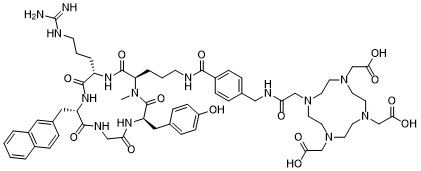
|
| DC40061 | DOTATATE Featured |
DOTATATE is a powerful tool in nuclear medicine, enabling the diagnosis and treatment of somatostatin receptor-positive tumors, particularly neuroendocrine tumors. When labeled with radionuclides like Ga-68 or Lu-177, it provides highly sensitive imaging and targeted therapy, making it a cornerstone in the management of these cancers. Its theragnostic potential allows for personalized treatment strategies, improving patient outcomes.
More description
|

|
| DC66469 | DOTA-NOC Featured |
DOTA-NOC (DOTA-Nal3-octreotide) is a high-affinity ligand of somatostatin receptor subtypes 2, 3 and 5. DOTA-NOC can be used for labeling with various radiometals, and development of radiopeptide imaging.
More description
|

|
| DC67285 | DOTA-Octreotide Featured |

|
|
| DC74649 | NOTA-TATE Featured |

|
|
| DC67284 | NOTA-NOC Featured |

|
|
| DC50044 | Edotreotide Featured |
Edotreotide is a synthetic somatostatin analogue that is used in nuclear medicine for the diagnosis and research of certain types of cancers, particularly neuroendocrine tumors (NETs). Somatostatin is a peptide hormone that inhibits the release of several other hormones, and many neuroendocrine tumors overexpress somatostatin receptors (SSTRs), making them ideal targets for somatostatin analogues like edotreotide.
More description
|

|
| DC66468 | NOTA-octreotide Featured |
NOTA-octreotide is a ligand for making [18F]AlF-NOTA-octreotide, which is a PET/CT imaging agent for somatostatin receptor imaging in neuroendocrine tumor patients
More description
|

|
| DC66467 | F-PSMA 1007 Featured |

|
|
| DC65339 | HBED-CC-tris(tBu) ester Featured |

|
|
| DC60103 | PSMA11 Featured |
PSMA-11 is a critical tool in nuclear medicine, enabling the synthesis of Ga-68-PSMA-11 for PET imaging of PSMA-expressing tumors. Its high specificity for PSMA, combined with the favorable properties of Ga-68, makes it a valuable diagnostic agent in the management of prostate cancer and potentially other malignancies.
More description
|

|
| DC33611 | PSMA-617 Linker Featured |
Vipivotide tetraxetan Ligand-Linker Conjugate (PSMA-617 Ligand-Linker Conjugate) is widely used in the treatment of metastatic castration-resistant prostate cancer (mCRPC) due to its ability to deliver targeted radiation directly to PSMA-expressing cancer cells, minimizing damage to surrounding healthy tissues.
More description
|

|
| DC12162 | PSMA-617 Featured |
PSMA-617 is a high potent prostate-specific membrane antigen (PSMA) inhibitor, with a Ki of 0.37 nM.
More description
|

|
| DC65336 | PSMA-1007 Featured |
PSMA-1007 is a novel Glu-Ureido-based prostate-specific membrane antigen (PSMA) inhibitor designed for use in positron emission tomography (PET) imaging of prostate cancer. It belongs to the class of small-molecule PSMA inhibitors that specifically target PSMA, a transmembrane protein highly expressed in prostate cancer cells and the neovasculature of other solid tumors. PSMA-1007 is particularly notable for its favorable pharmacokinetic properties, including high tumor uptake and low urinary excretion, making it an excellent tool for prostate cancer diagnosis and staging.
More description
|
.gif)
|
| DC23004 | PSMA-ligand-1 Featured |
PSMA ligand-tubulysin compounds represent a cutting-edge approach to targeted cancer therapy, combining the precision of PSMA targeting with the potent cytotoxicity of tubulysin. This strategy holds significant promise for improving outcomes in prostate cancer and other PSMA-expressing malignancies, offering a highly specific and effective treatment option with reduced systemic toxicity. As research progresses, these compounds could play a transformative role in the field of oncology.
More description
|

|
| DC66465 | Pentanedioate Featured |
Pentanedioate is a valuable starting material for the synthesis of PSMA inhibitors due to its flexible structure and functional groups that mimic natural PSMA ligands. By leveraging its chemical properties, researchers can develop potent and selective PSMA-targeting agents for diagnostic imaging, targeted therapy, and theranostic applications in prostate cancer and other PSMA-expressing malignancies. Its role in drug discovery highlights the importance of simple organic molecules in the development of advanced cancer therapies.
More description
|

|
| DC71440 | FAP-2286 Featured |
FAP-2286 is a highly promising FAP-targeting theranostic agent with potent affinity for FAP, versatile radionuclide coupling capabilities, and demonstrated antitumor activity. Its ability to serve as both a diagnostic imaging agent and a therapeutic tool makes it a valuable asset in oncology, particularly for cancers with prominent stromal involvement. As research progresses, FAP-2286 has the potential to significantly advance cancer diagnosis, treatment, and research, offering new hope for patients with FAP-expressing tumors.
More description
|

|
| DC66464 | 3BP-3940 Featured |
3BP-3940 is a highly potent FAP-targeting peptide with significant potential in theranostics. Its ability to be coupled with diagnostic and therapeutic radionuclides makes it a versatile tool for tumor imaging, targeted therapy, and treatment monitoring. By focusing on the tumor stroma, 3BP-3940 offers a promising approach to improving cancer diagnosis and treatment, particularly for cancers with prominent stromal involvement. As research progresses, 3BP-3940 could play a key role in advancing precision oncology.
More description
|

|
| DC66114 | FAPI-46 Featured |
FAPI-46 is a highly promising FAP-targeted radiotracer with superior tumor uptake and prolonged accumulation, making it an excellent tool for imaging a wide range of cancers. Its versatility, combined with its potential for theragnostic applications, positions FAPI-46 as a valuable asset in the field of oncology, enabling improved diagnosis, staging, and treatment monitoring for patients with FAP-expressing tumors.
More description
|

|
| DC66460 | FAPI-4 Featured |
FAPI-4 is a potent FAP inhibitor with significant applications in cancer research and diagnostics. Its radiolabeled form, ⁶⁸Ga-FAPI-4, is a promising PET/CT imaging agent for visualizing FAP-expressing tumors with excellent tumor-to-background contrast. This makes it a valuable tool for cancer diagnosis, staging, treatment monitoring, and therapeutic development, particularly in cancers with a prominent stromal component.
More description
|

|